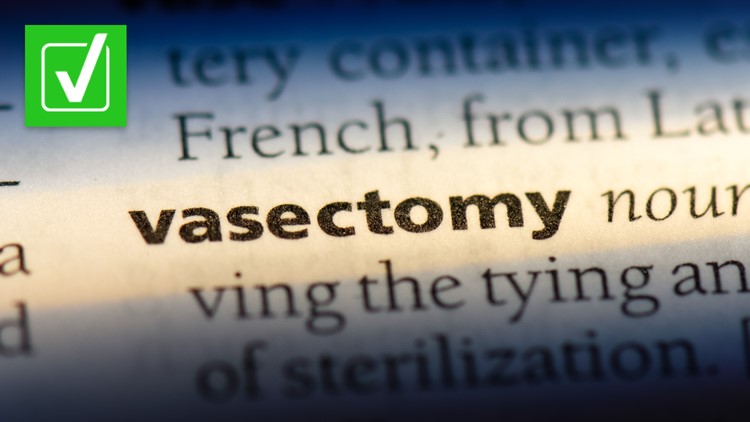Update June 27, 2022: On June 24, the Supreme Court overturned Roe v. Wade. This story has been updated to reflect the final decision.
Roe v. Wade, a decades-old ruling that made the right to abortion federally protected in the U.S. was overturned by the Supreme Court on June 24.
The court decision was predicted in May, when a leaked draft of a Supreme Court majority opinion was published by POLITICO. The draft, penned by Justice Samuel Alito, suggested the court would overturn Roe v. Wade
In the days following the leak, some online users, including actress Bette Midler, shared a meme that says: “Stop abortion at the source. Vasectomies are reversible. Make every young man have one. When he’s deemed financially & emotionally fit to be a father it will be reversed. What’s that? Did the idea of regulating a man’s body make you uncomfortable? Then mind your [expletive] business.”
VERIFY viewer Jared on Instagram asked: “Is this meme true? I was always under the impression they were reversible but with questionable results. Is it true vasectomies are reversible?”
THE QUESTION
Are vasectomies reversible?
THE SOURCES
- Amin Herati, M.D., a urologist at Johns Hopkins Hospital
- Stan Honig, M.D., a professor of urology at Yale School of Medicine
- Mayo Clinic
- Vasectomy Reversal Center for America
- Stanford Health Care
- Planned Parenthood
THE ANSWER
Yes, vasectomies are reversible. Vasectomy reversals are 90% to 95% effective, Stanford Health Care says. But, they can be expensive and typically aren’t covered by health insurance.
WHAT WE FOUND
A vasectomy is a medical sterilization procedure that stops sperm from being able to get to semen. To perform a vasectomy, a urologist removes a small section of the vas deferens, or the sperm duct, in both testicles.
With a “no-scalpel” method, a small puncture hole is made on the side of the scrotum, the doctor locates the vas deferens under the skin and pulls it out through the puncture hole to cut it. The procedure is conducted on both testicles. This is the most common method for a vasectomy.
A vasectomy is an outpatient procedure and could cost anywhere between $0 (if insurance covers the procedure) to $1,000, according to Planned Parenthood.
A vasectomy reversal undoes those procedures, and could cost several thousands dollars. For instance, at some Mayo Clinic locations, the reversal could cost up to $16,000. The cost varies depending on how invasive the procedure is or if there are complications that require use of anesthesia, Mayo Clinic says.
During the reversal procedure, a surgeon reconnects each vas deferens that carries sperm to the semen. After a successful vasectomy reversal, sperm are again present in the semen, and the patient may be able to get their partner pregnant.
According to the Vasectomy Reversal Center for America, “After a vasectomy reversal, it can take a couple of turnovers of sperm reserve, or approximately six to nine months, before sperm count returns to a level where getting pregnant is optimal. At this point, it can still take another six months or so for a couple to conceive.”
Vasectomy reversals are 90% to 95% effective, Stanford Health Care says.
The procedure is expensive and may not be covered by insurance, Stan Honig, M.D., a professor of urology at Yale School of Medicine, told VERIFY. He said despite those obstacles, 6% to 8% of people choose to get a vasectomy reversed.
“Most of the time, couples are a second marriage, divorce, remarriage, or new partner with no children. Every once in a while a couple changes their mind, or a child dies, something along those lines after a vasectomy. But most of the time, it's a second partner, and they want to have a family with a new partner,” Honig said.
Amin Herati, M.D., a urologist at Johns Hopkins Hospital, said there are some factors that make it more difficult to have a successful reversal, including time passed since the vasectomy was performed.
“The factors that determine the success of the reversal depend largely on how far out the patient is from the time of the dissection. So the vasectomy was done more than 10 years out, then the chances of the reversal become less likely to be successful,” Herati said.
An alternative procedure to avoid a reversal is sperm procurement, Honig said. The sperm are extracted, saved, and then later used in conjunction with in vitro fertilization (IVF).
Vasectomy reversal rarely leads to serious complications, according to Mayo Clinic. Mayo Clinic suggests considering these factors when thinking about a vasectomy reversal:
- Vasectomy reversal may be expensive, and your insurance might not cover it.
- Vasectomy reversals are generally most successful when they're done by a surgeon who is trained in and uses microsurgical techniques, including those that make use of a surgical microscope.
- The procedure is most successful when performed by a surgeon who does the procedure regularly and who has done the procedure many times.
- The procedure occasionally requires a more complex type of repair, known as a vasoepididymostomy. Make sure that your surgeon is able to perform this procedure if it's required.
So, we can VERIFY vasectomies can be reversed, but there are some factors to consider before making the choice.













